Since the death of the Queen, questions have arisen about the fate of her corgis, the pets she has treasured since childhood. Now it has been revealed her beloved dogs will be looked after by her son Prince Andrew and his ex-wife, the Duchess of York. This is the story of how Elizabeth and her corgis became inseparable.
1959: Queen Elizabeth II, aged 32 and a mother of two, sits designing a gravestone for her dog.
Susan showed up on her 18th birthday, and would gatecrash her honeymoon a few years later, smuggled beneath a rug in the royal carriage after her wedding to Prince Philip.
"I had always dreaded losing her," the Queen wrote in her grief, "but I am ever so thankful that her suffering was so mercifully short."
That Susan bit the royal clock-winder and a young palace sentry is a matter of record, though her epitaph leaves out such indiscretions. She was buried in the pet cemetery at Sandringham, started by famously committed mourner Queen Victoria.
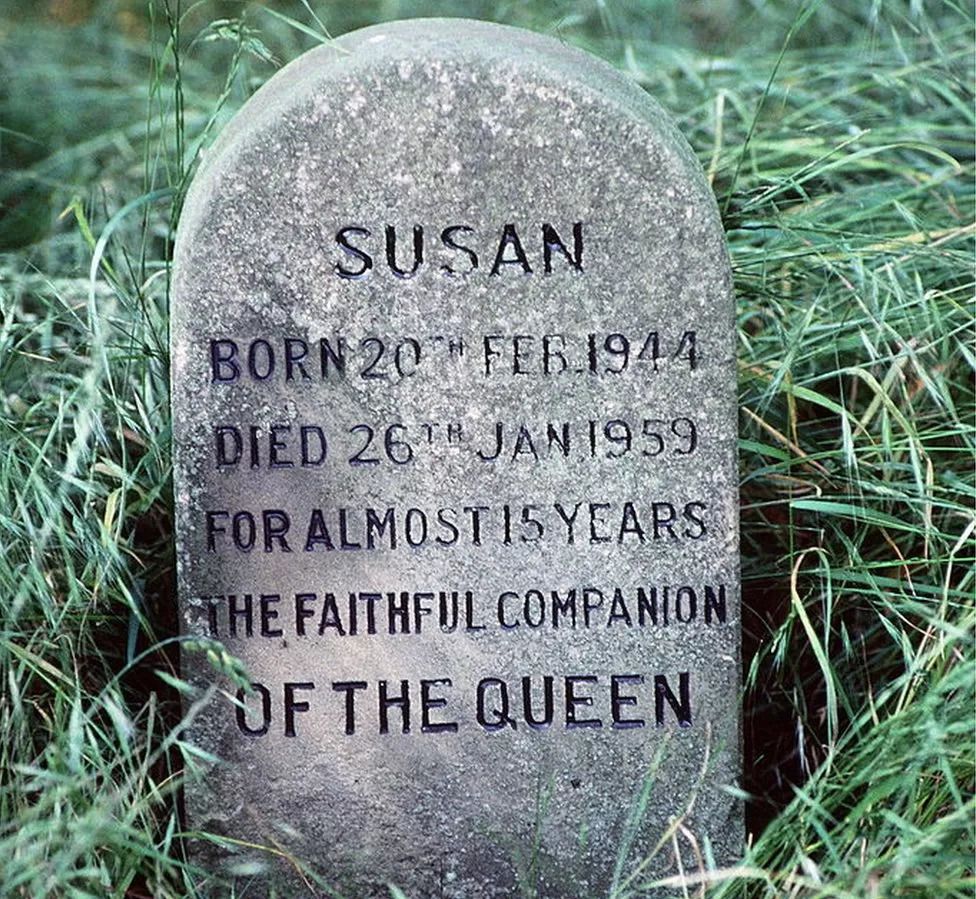 Susan's gravestone stands in the pet cemetery at Sandringham, the royal estate in Norfolk
Susan's gravestone stands in the pet cemetery at Sandringham, the royal estate in Norfolk
An ending for one Pembroke Welsh corgi - but certainly not for Her Majesty, who was only just getting started.
Over the next six decades, she would own more than 30 of Susan's descendants, single-handedly create a mass market for this stunted Welsh cattle dog, and accidentally invent the dorgi with the help of Princess Margaret's amorous dachshund, Pipkin.
Why corgis? The answer, which may resonate with parents, is that some friends had one in 1933 when Princess Elizabeth was seven years old, and she wanted one too.
Pembroke corgis were a familiar sight in Wales, but fairly new to England. The Duke of York, Elizabeth's father, approached a respected breeder named Thelma Gray who brought the family three puppies from her Rozavel kennels in Surrey to choose from.
They settled on a little corgi officially called Rozavel Golden Eagle, because he was the only one with a small stump of tail to wag - and they wanted to know when he was pleased. But the pup became known as Dookie, reportedly after the kennel staff heard the Duke of York was going to be his owner, and the nickname stuck.
Dookie was horribly behaved, biting courtiers and visitors with abandon - but that didn't stop a press photo of Elizabeth and the tiny tyrant charming the public and raising the Pembroke corgi's profile.
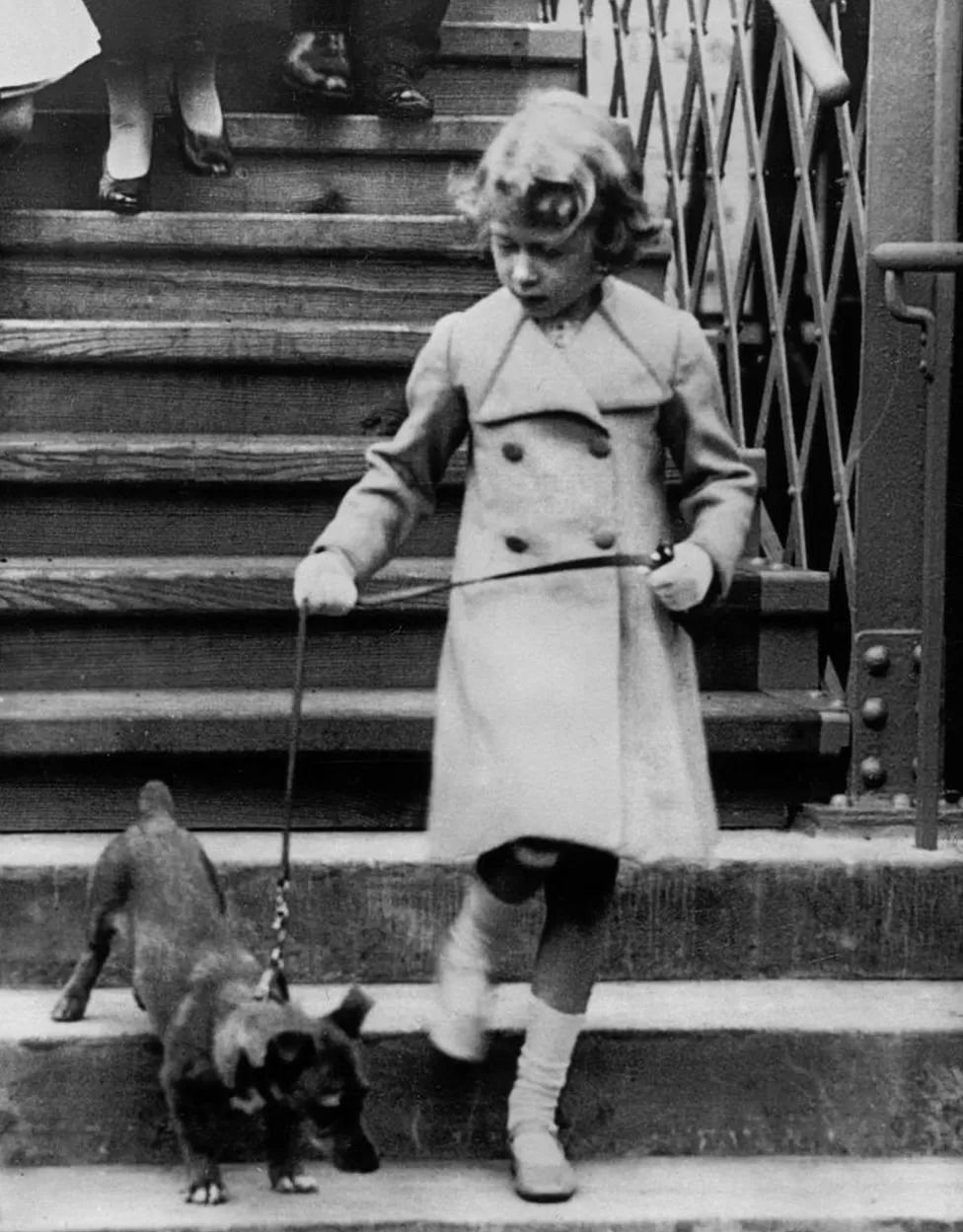 Princess Elizabeth pictured at Glamis Station with Dookie just after he joined the family
Princess Elizabeth pictured at Glamis Station with Dookie just after he joined the family
Another puppy, Lady Jane, arrived from the same breeder a few years later. Christmas 1936 then saw a royal PR coup in the form of a saccharine children's book - Our Princesses and Their Dogs - which styled the Yorks and their pets as "one very human family". The book, brimming with dog pictures and family values, went on sale just days before the Duke's elder brother abdicated, making him the new king.
Buckingham Palace is extremely tight-lipped about anything to do with the Queen's dogs because they're seen as a "private matter". But it's clear the royals cottoned on early to the softening effect of a well-timed corgi.
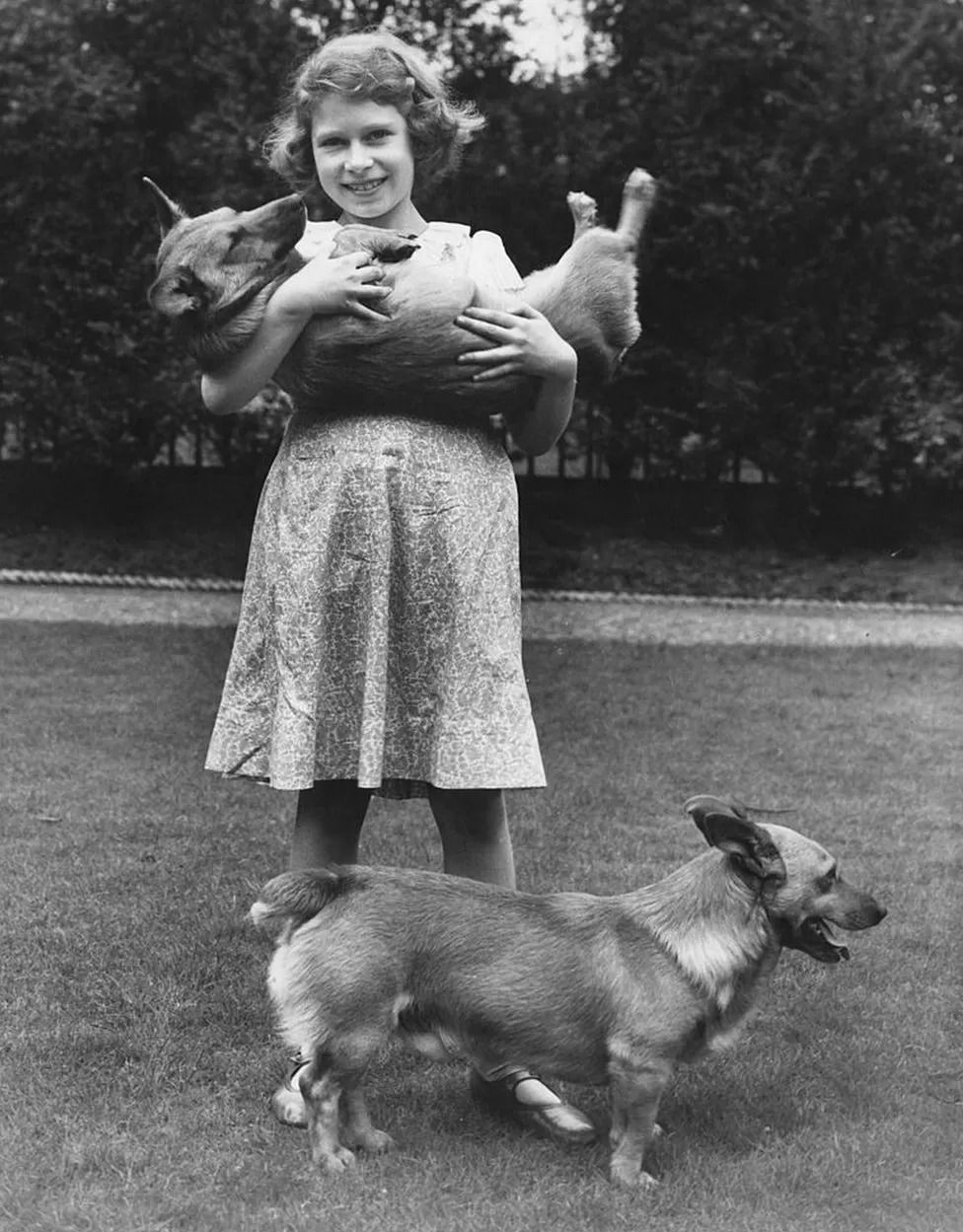 Princess Elizabeth with her first corgis - Dookie and Jane - at her childhood home in Piccadilly, London, July 1936
Princess Elizabeth with her first corgis - Dookie and Jane - at her childhood home in Piccadilly, London, July 1936
Kennel Club figures show a clear spike in Pembroke corgi registrations in 1936, and another in 1944, the year Princess Elizabeth got Susan. She had made corgis cool, while they made her look warm.
"People - breeders - were servicing the market for a dog that has suddenly become very popular. It's the 101 Dalmatians effect," notes Ciara Farrell, the Kennel Club's Library and Collections Manager.
"You see it with advertising as well - the old English sheepdog on the Dulux advert in the 70s and 80s." Likewise, the Andrex puppy, a marketing masterstroke that's run for half a century.
Away from the cameras, Princess Elizabeth and Susan were inseparable. Add to that a royal's awareness of lineage, and it's no surprise she turned to Thelma, provider of her childhood puppies, to find Susan a mate. Rozavel Lucky Strike was the dog for the job, and founded a line of Windsor Pembroke corgis, which continued for 14 generations.
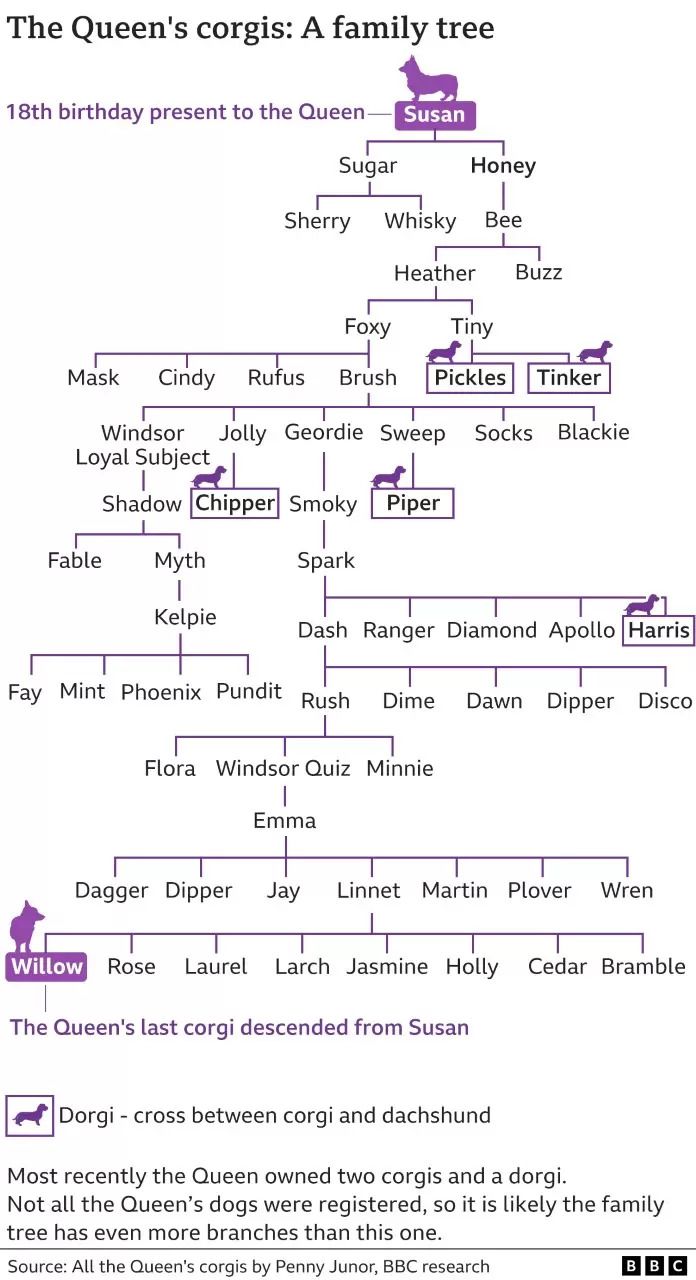
As well as being the Queen's much-loved pets, the corgis were a connection to her father, and a more carefree time. Every puppy after Susan was a way of keeping part of that with her, and a reminder that life and dynasties go on.
While her husband Prince Philip spent a lifetime walking a little behind his wife, the corgis scampered ahead - revelling in a freedom denied to the Queen herself. Princess Diana is said to have coined the phrase "a moving carpet" to describe the jumble of dogs that preceded her. But the Queen called them "the girls" and "the boys". In all her years of breeding, she never sold any of her puppies. All stayed with her, or were given to breeders, relatives or friends.
 Two of the Queen's dogs escort her through the door, as she greets a
visiting New Zealand rugby team at Buckingham Palace in 2007
Two of the Queen's dogs escort her through the door, as she greets a
visiting New Zealand rugby team at Buckingham Palace in 2007
The corgis went where the Queen went - from palace to palace. This included on helicopters, trains, and in limousines. At Christmas at Sandringham they each had their own stocking, filled by the Queen herself.
Buckingham Palace has 775 rooms, but the corgis slept inside the Queen's private apartment. As royal author Penny Junor wrote in her book All The Queen's Corgis: "There is a special corgi room where they have raised wicker baskets lined with cushions to keep draughts away."
Walking them every day was a part of her routine before mobility issues affected her final months. And in bygone years, she liked nothing more than piling the pack into an elderly Vauxhall estate, donning a headscarf, and setting off for a drive.
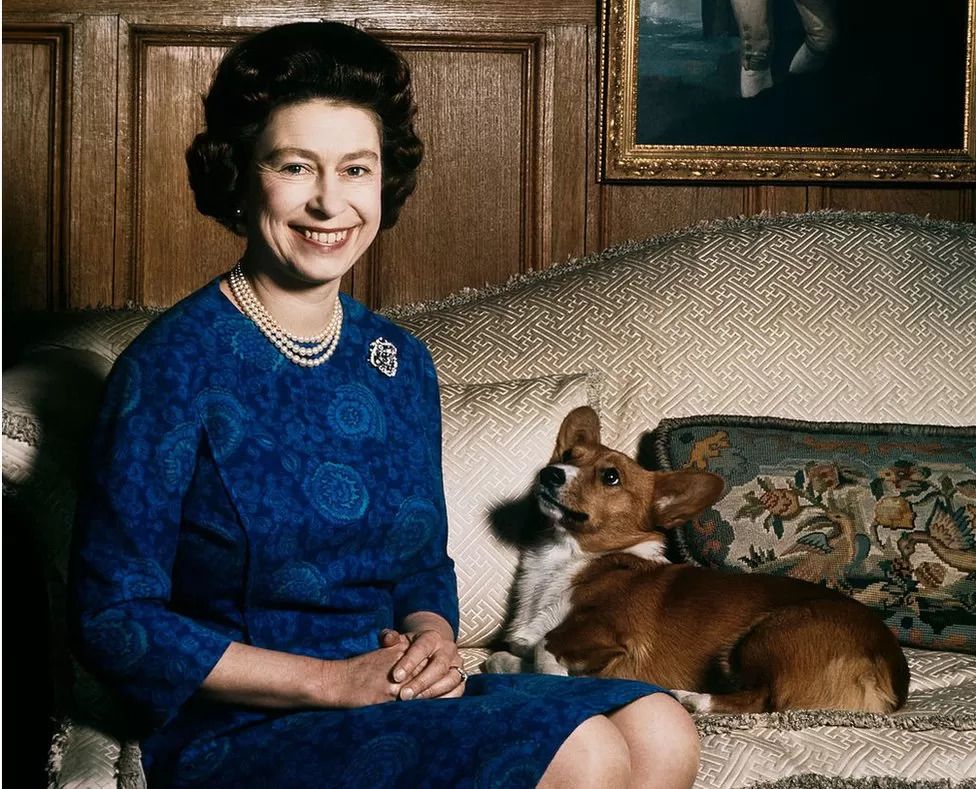 The Queen took her dogs everywhere, including by plane. (Pictured in 1970)
The Queen took her dogs everywhere, including by plane. (Pictured in 1970)
A typical dog's life doesn't feature thousands of acres to roam, or lavish meals - prepared in the royal kitchens - of steak, chicken breast, vegetables and rice. But Junor believes that in some ways, corgis gave the Queen a precious point of contact with everyone else.
She wrote: "Dogs and horses are her passion and it is with them, and the people who share that passion, that she truly relaxes. Horses are a rich man's game but dogs are not. They are a great leveller, they attract people from all walks of life and, over the years, the Queen has had strong and genuine friendships with many of her fellow dog enthusiasts."
Between 1933 and 2018, the Queen always owned at least one corgi - but mostly it was many more than that. Prince Philip, who never shared his wife's fondness for the breed, was apparently heard to complain: "Bloody dogs! Why do you have to have so many?"
And then there were the dorgis - initially the result of an illicit liaison between Princess Margaret's dachshund, Pipkin, and a corgi named Tiny in the 1970s. The Queen and Princess Margaret were so charmed by the outcome that they mated the dogs again, and about 10 dorgi pups were born over the years.
They've varied in appearance, with some ears pointing up, corgi-like, and others hanging down. But all of them had long tails and were smaller than pedigree corgis.
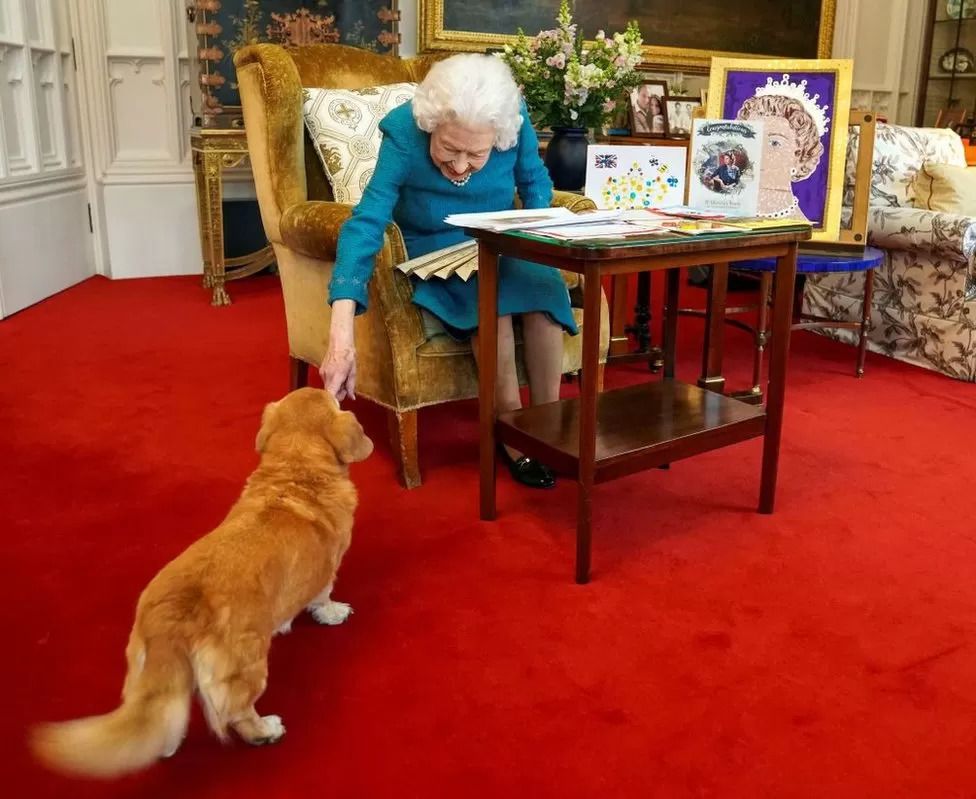 The Queen strokes her dorgi Candy, as she looks at memorabilia from her Golden and Platinum Jubilees in January 2022
The Queen strokes her dorgi Candy, as she looks at memorabilia from her Golden and Platinum Jubilees in January 2022
When a royal photographer asked how the mechanics worked given the height difference between corgis and dachshunds, the Queen replied: "It's very simple. We have a little brick."
In some cases, when loved ones died the Queen even adopted their dogs. This included the Queen Mother's three corgis in 2002. According to Vanity Fair, when the Queen went to Clarence House to view her mother's body, she took the Queen Mother's corgis home with her directly.
She adopted another - Whisper - who had belonged to her former head gamekeeper at Windsor, Bill Fenwick, and his wife Nancy. The latter was a dear friend who helped with the Queen's corgi breeding for five decades, and one of the very few people whose calls were always put through to her no matter what.
The royal household's breeding programme ended several years ago, as the Queen was said to be unwilling to leave young dogs behind when she died. She was pictured with her surviving dorgi, named Candy, back in January. She also had two young corgis named Muick and Sandy, who were gifts from her son Prince Andrew and his daughters in 2021.
It has now been confirmed that the pair will go to live with the prince and his ex-wife, Sarah, Duchess of York, at Royal Lodge, a mansion in the grounds of the Windsor estate.
It is unclear at time of writing whether Candy will join them.
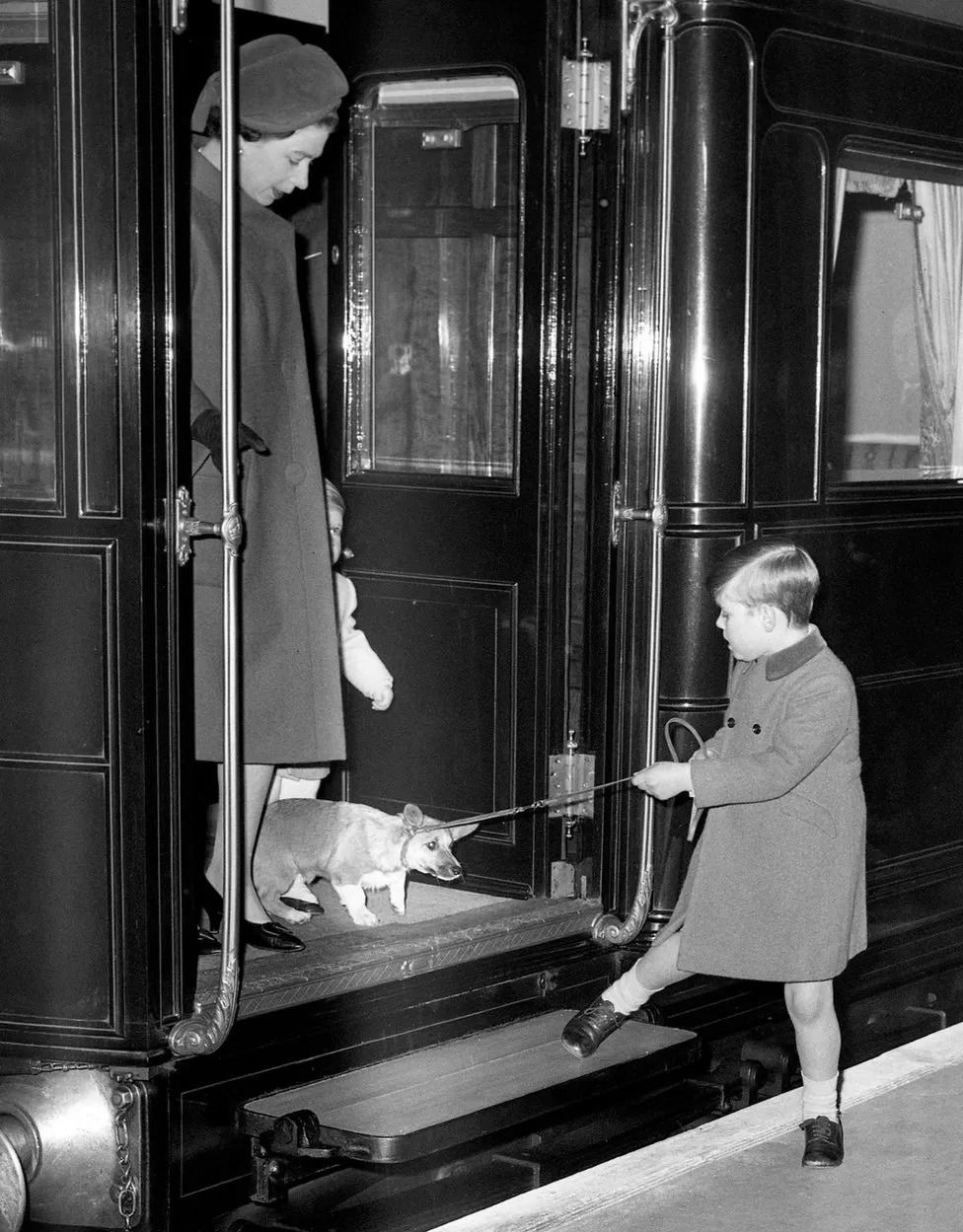 Prince Andrew and the corgis have a lifelong association. (Pictured in 1966)
Prince Andrew and the corgis have a lifelong association. (Pictured in 1966)
The prince hasn't always profited from the corgis' presence. Junor observes that the Queen, "essentially a very shy woman" who was required to talk confidently to strangers, used the dogs to reduce her discomfort - including with her relatives.
"Her family refers to it as 'the dog mechanism' […] If the situation becomes too difficult she will sometimes literally walk away from it and take the dogs out. Prince Andrew is said to have taken three weeks to fight his way past the dogs to tell his mother that his marriage to Sarah Ferguson was in trouble," she wrote.
The Queen also deployed the dogs to put others at ease. War surgeon Dr David Nott described how the monarch got him through a lunch at Buckingham Palace when he had just returned from Aleppo, in war-torn Syria, and found himself unable to speak to her due to Post-Traumatic Stress Disorder (PTSD).
The Queen sensed something was wrong and said, "Well, shall I help you?" before calling for her corgis, Dr Nott said.
"All of a sudden the courtiers brought the corgis and the corgis went underneath the table." The Queen opened a tin of biscuits. "And so for 20 minutes during this lunch the Queen and I fed the dogs. She did it because she knew that I was so seriously traumatised."
Because Her Majesty lived to 96 years old, there are millions of people old enough to own dogs who have only ever known her as a grey-haired grandmother and great-grandmother.
As a result, corgis came to be viewed as an old person's breed for a time.
Their ascendency peaked in the 1960s with almost 9,000 puppy registrations, as the public cooed over pictures of the Queen with her young family and dogs. But from the late 1990s in particular the decline is marked, and 2014 was their annus horribilis. With just 274 new registrations, Pembrokes trotted into the Vulnerable Native Breed category in the UK.
Then came Netflix, and salvation in the form of The Crown, whose first season in 2016 turned the clock back to the start of the Queen's reign. Sympathetically played by Claire Foy, whose nuanced performance included a litany of expressive ways to say the word "oh…", the youthful royal was frequently surrounded by a pack of corgis, as was Olivia Colman, her successor in the role.
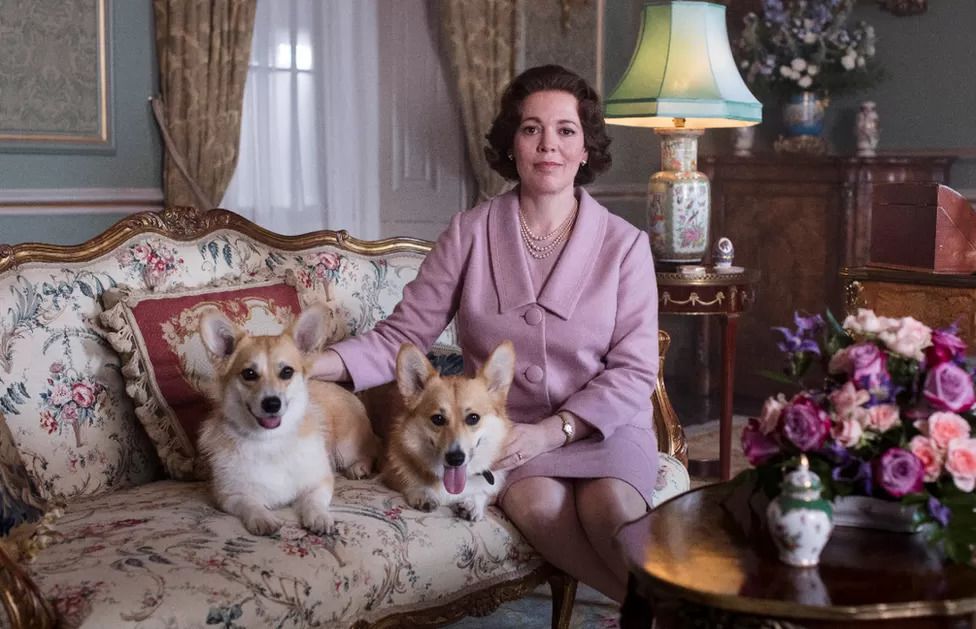 Olivia Colman in character as the Queen, with her co-stars
Olivia Colman in character as the Queen, with her co-stars
Foy told Vanity Fair how the on-set dogs were bribed with treats and especially loved cheese, mulling: "You sort of worry that they're going to have a heart attack when you're giving it to them. These Corgis are cheesed up to the max - they're eating like a whole block of cheddar every day. It's scary."
Numbers rebounded, with corgi puppy registrations up by 16% in 2017 after the first season aired, and 47% in 2018 after the second. It wasn't just about The Crown. The James Bond skit starring the Queen and three royal corgis at the 2012 Olympics opening ceremony also saw them tummy-roll back into the public consciousness.
Even Bridgerton - Netflix's wildly popular Regency romp - inserted a historically improbable corgi into series 2. Co-star reviews included "doesn't move if he doesn't have a treat", but audiences loved him.
Social media has also been vital to the corgi renaissance, as Chris Equale, owner of TikTok stars Hammy and Olivia, knows well.
Chris, 34, launched a viral sensation pretty much accidentally in April 2020, with a video of his corgi Olivia barking at the vacuum cleaner. "It got 250,000 views in just under 20 minutes," he remembers.
Two years and seven million followers later, he's made more than 700 talking corgi skits. They include a running joke about the dogs' war with "the dragon" (their dust-blitzing nemesis), and the vacuum company has piled in to sponsor content.
Asked what it is about corgis that charms people, he replies: "There's something very unique about a corgi - it's just a dog you really want to root for. They're the greatest herders you'll ever see! But if you look at them at first glance it's like, is it a dog, is it a loaf of bread? There's something so lovable about them."
The Kennel Club's Ciara Farrell agrees corgi anatomy is central to their kitsch appeal.
"One of the things is that people love a big ear - something you can lean into if you're making a soft toy. They're a spitz breed, so pointy in the face, brings that foxiness in. They look sort of tough but cute."
Mr Equale sees the Queen as "the pioneer of the breed" which he describes as looking like an oversized potato, enthusing: "I've only had these two [Hammy and Olivia] for like… seven years? So to do that 10 times over is just fascinating.
"At a dog park it's always the first thing that comes out of a passer-by's mouth: 'Oh you know those are the Queen's dogs!'"
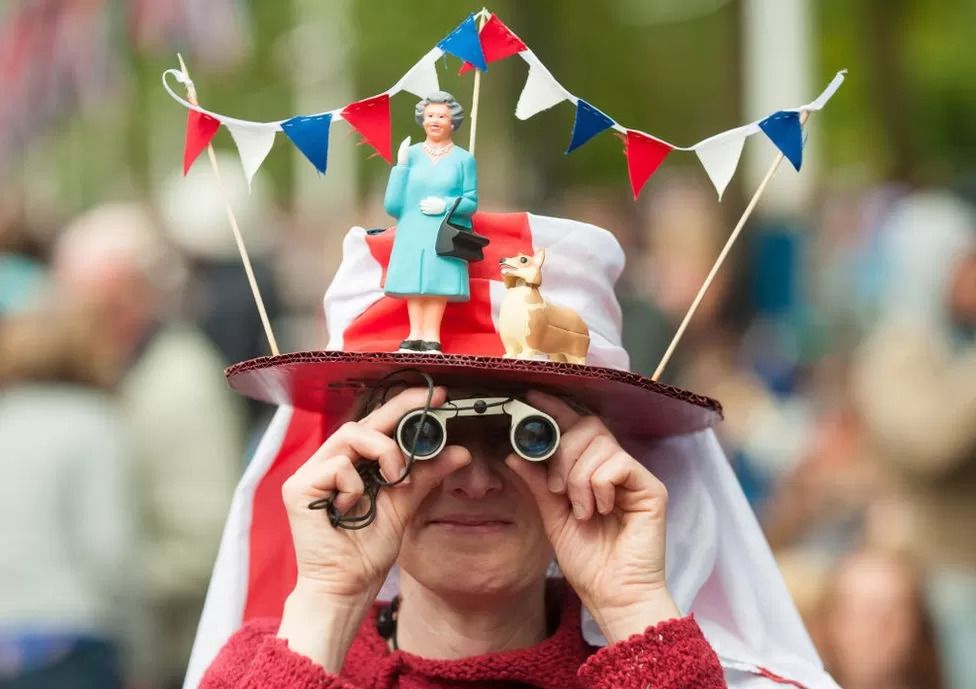 Corgis and the Queen: A branding partnership known the world over
Corgis and the Queen: A branding partnership known the world over
The breed was inextricably tied to the monarchy in the public imagination while the Queen reigned. But in the era of King Charles III, who once quipped that he prefers Labradors and is a long-time owner of Jack Russell terriers, can corgis expect another dip in popularity?
"I would hope not," says Ms Farrell. "I think corgis have made great progress in recent years." She believes they'll always be the Queen's iconic dogs, but the more that potential owners see corgis online, the less vital a royal association will be.
"There's going to be a generation of people who use social media who will find them characterful and fun. I think they're here to stay, definitely."
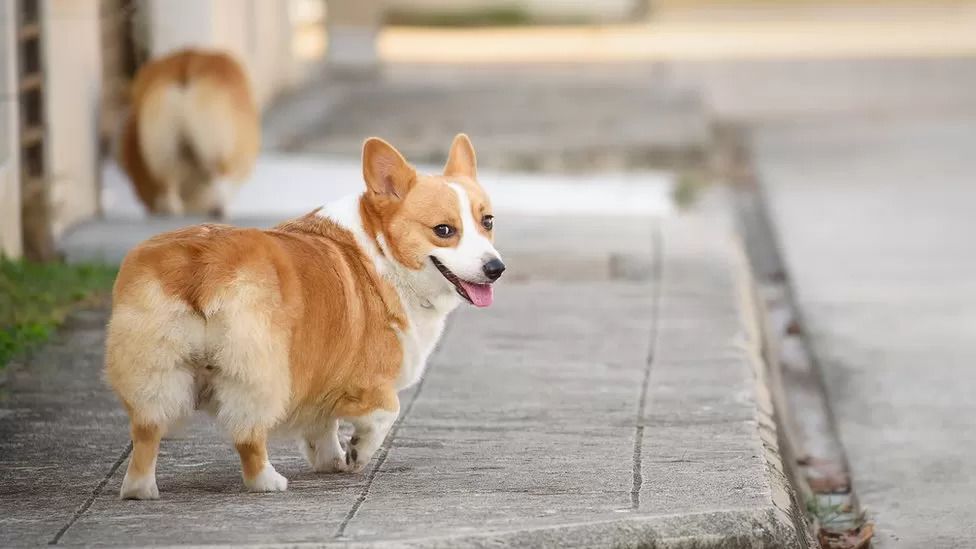
WATCH: Hammy and Olivia's owner on the breed's unique appeal















